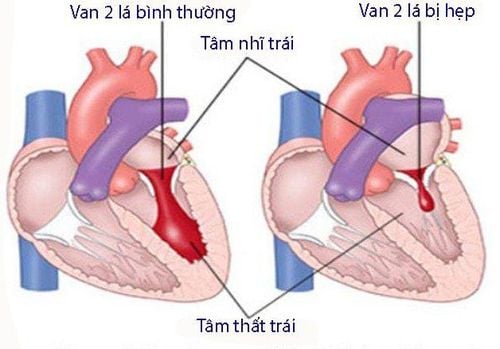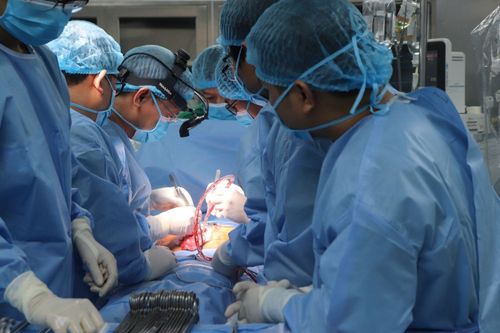This is an automatically translated article.
The article is professionally consulted by Master, Doctor Tran Hong Nhat - Interventional Cardiologist - Cardiovascular Center - Vinmec Central Park International General Hospital.Atrial septal defect is a congenital heart defect that accounts for 15-20% of all recorded congenital heart diseases. The disease affects the health and comprehensive development of children. However, if detected early and treated properly, children will be able to develop normally.
1. What is ventricular septal defect?
An atrial septal defect is an abnormal hole in the septum between the two atria. This hole causes blood in the 2 atria to mix and disturb the flow of blood in the heart, resulting in increased blood flow to the lungs, causing pulmonary hypertension, heart failure ...2. Pathological manifestations
Most of the symptoms often appear late, patients often come to the doctor because of shortness of breath with exertion, or because of the manifestation of bronchopneumonia many times. In a small number of cases with a large fistula, the baby will show signs as early as 6 to 12 months.
Common manifestations of the disease in the late stage such as: arrhythmia (atrial fibrillation or flutter), severe pulmonary hypertension and congestive heart failure.
3. Methods of treating atrial septal defect

Current treatment methods: Internal medicine, surgery and interventional cardiac catheterization
3.1. Medical treatment Patients with atrial septal defect without hemodynamic effects need periodic monitoring.
Medical treatment for complications of pulmonary hypertension, arrhythmia, heart failure ... helps to stabilize the disease before surgery or is a supportive method for patients who are too indicated for intervention or surgery.
3.2. Surgical treatment This is an open surgery method to patch the atrial septal defect with the help of an artificial heart and lung machine.
Indications for surgery in patients with large orifice, affecting hemodynamics (right ventricular dilatation, pulmonary hypertension...).
3.3. Percutaneous septal occlusion is a minimally invasive treatment. A stoma closure device is inserted through the catheters into the heart to patch the hole.
3.3.1 Indications: Large flow can affect hemodynamics Atrial septal defect is secondary and the hole size is not too large (≤ 34mm, measured on echocardiography). There is a sufficiently wide periphery of the foramen (atrioventricular valvular edge, right pulmonary venous edge, aortic margin, superior and inferior venous ridge): ≥ 5 mm. 3.3.2. Contraindications Cases with primary foramen septal defect, venous sinus hole Atrial septal defect combined with other congenital heart abnormalities requiring total surgical repair Patients with severe coagulopathy Patients with Medical management, severe surgery can not intervene cardiac catheterization Fixed pulmonary artery pressure. 3.3.3. Advantages of the method of occlusion of the atrial septal defect with a percutaneous instrument
The method is safe and does not require a lot of technical means, which can be routinely deployed in facilities with cardiac catheterization rooms. The method is more aesthetic than open surgery with the classic mid-sternal incision Reduced trauma, less pain, less bleeding The patient is fully awake during the procedure, and the recovery process health , hospital stay is significantly reduced Rate of wound infection is minimized.
4. Some special notes

4.1. Atrial septal defect usually has little early effect, and especially with small holes that can close on their own, so there is no need for early intervention if the child does not have hemodynamic disturbances: dilated heart chambers, heart failure, increased Pulmonary arterial pressure .... Ideally, intervention should be done when the child is old enough, at 4-5 years old and should not be left too late, because it will more or less affect the structure and function of the heart.
In adults, if disease is detected, the atrial septal defect should still be closed when the pulmonary artery pressure and resistance are not too high.
4.2. Incisional incision Percutaneous atrial septal defect closure, with minimally invasive method, the patient has almost no scars after the intervention
Open heart surgery with minimally invasive surgical technique: small incision, located under the line below right breast ridge layer, ensuring aesthetics for patients, especially female patients
Currently, all Vinmec International General Hospitals across the country can perform closure of the atrial septal defect by interventional method. Percutaneous intervention with a methodical and strict process, ensuring safety, accuracy and high treatment efficiency.
Vinmec with advanced equipment and a team of experienced and well-trained doctors and nurses, professional and dedicated patient care services will help patients have the most secure experience during surgery. Minimally invasive open heart here.
Please dial HOTLINE for more information or register for an appointment HERE. Download MyVinmec app to make appointments faster and to manage your bookings easily.














